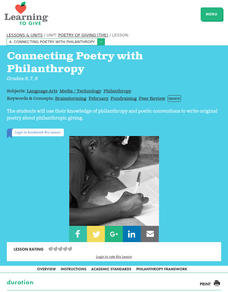Curated OER
Rhythm and Rhyme
Young scholars, after talking about form, create a more focused learning space with a collective purpose.
Curated OER
Hot, Hot, Hot, Cold
Learners dance the image of falling snow. They move, swing, fall, and rise to music working to depict snow falling, the sun, and high/low movements. This is a well-thought out lesson that aids them in seeing movement as a form of...
Nemours KidsHealth
Diabetes: Grades K-2
Second graders complete 2 lessons where they complete hands on activities to learn about diabetes, insulin, and type 2 diabetes prevention. For this diabetes lesson plan, 2nd graders use hula hoops, sidewalk chalk, tape, and more.
Curated OER
Special Place
Students observe and describe a "special place" chosen along a nature trail. In this habitat observational skills and writing lesson, students take a walk on a nature trail and choose a spot to sit and meditate. Students complete a...
Curated OER
Improvisation
High schoolers are introduced to the concept of improvisation. In groups, they practice improvising a different scenario given to them and explore the various ways people communicate with each other. To end the lesson, they reflect on...
Curated OER
Connecting Poetry with Philanthropy
Students use their knowledge of philanthropy and poetic conventions to write original poetry about philanthropic giving. In this philanthropy lesson, students write poetry based on philanthropy using poetic conventions. Students...
Curated OER
Connecting Poetry with Philanthropy
Students examine the different types of poetic conventions. They write a poem about philanthropy using these conventions. They illustrate their poem with artwork of their choice.
Curated OER
Pyramid Play
Students investigate the concept of the Food Pyramid. They use a game as a tool of discovery in order to classify different types of food in the pyramid. Upon completion of the game the students construct their own models of it.









